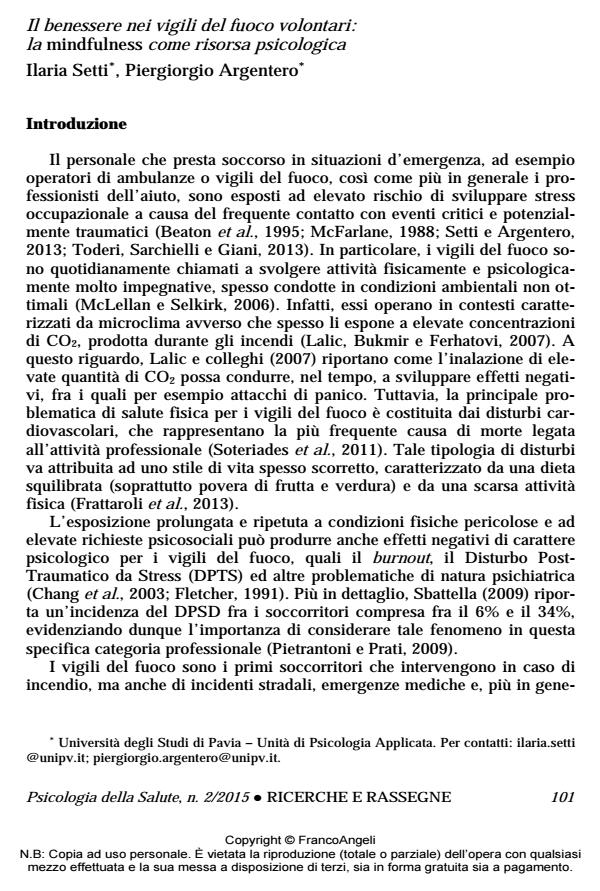Well-being among volunteer firefighters: mindfulness as psychological resource
Journal title PSICOLOGIA DELLA SALUTE
Author/s Ilaria Setti, Piergiorgio Argentero
Publishing Year 2015 Issue 2015/2
Language Italian Pages 21 P. 101-121 File size 103 KB
DOI 10.3280/PDS2015-002006
DOI is like a bar code for intellectual property: to have more infomation
click here
Below, you can see the article first page
If you want to buy this article in PDF format, you can do it, following the instructions to buy download credits

FrancoAngeli is member of Publishers International Linking Association, Inc (PILA), a not-for-profit association which run the CrossRef service enabling links to and from online scholarly content.
This study aimed at exploring occupational well-being among volunteer firefighters (N=99). More in detail, we have investigated the influence of two important psychological resources, engagement and mindfulness, as protective factors against the risk of developing negative health effects, in terms of post-traumatic and psychosomatic symptoms. Firefighters completed the following self-report questionnaires: the Utrecht Work Engagement Scale- 9; the Mindful Awareness Attention Scale; the Secondary Traumatic Stress Scale; and the General Health Questionnaire-12. The results, deriving from regression models, show that only mindfulness provides full protection against the risk of developing vicarious trauma and psychosomatic symptoms. From an applicative perspective, our findings suggest the importance of developing interventions aimed at increasing mindfulness, which may support volunteer firefighters in facing both chronic and acute occupational stressors.
Keywords: Volunteer firefighters, psychosomatic well-being, mindfulness, engagement
- INTERVENÇÕES EM PROMOÇÃO E PREVENÇÃO EM SAÚDE MENTAL ENTRE PROFISSIONAIS DE SEGURANÇA PÚBLICA Luana Folchini da Costa, Magda Macedo Madalozzo, Alexandra Carol Cioato, Éder Leonardo De Vitte Horn, in Revista Brasileira de Segurança Pública /2025 pp.350
DOI: 10.31060/rbsp.2025.v19.n2.2163
Ilaria Setti, Piergiorgio Argentero, Il benessere nei vigili del fuoco volontari: la mindfulness come risorsa psicologica in "PSICOLOGIA DELLA SALUTE" 2/2015, pp 101-121, DOI: 10.3280/PDS2015-002006